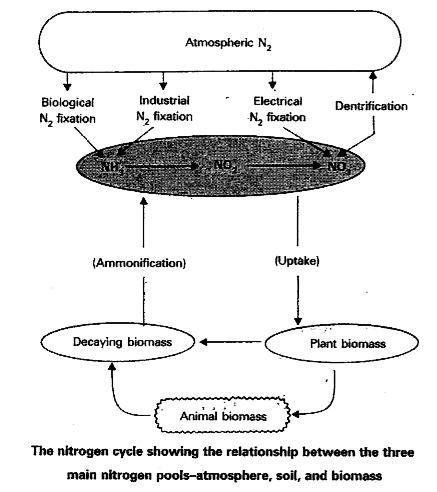Explain the Nitrogen cycle, giving relevant examples.Solution in Telugu
The cyclic movement of nitrogen-from the atmosphere to soil and from soil back into the atmosphere through plants, animals and micro-organisms is termed as nitrogen cycle. Nitrogen7 cycle is a continuous pathway and it involves five steps.
1) Nitrogen Fixation
2) Nitrogen .Assimilation
3) Ammonification
4) Nitrification
5) Denitrification
1) Nitrogen Fixation : The gaseous dinitrogen is fixed into inorganic nitrogenous substances is called nitrogen fixation. It occurs by two methods.
a) Abiological or physical method, b) Biological method - Diazotrophy
a) Abiological or physical method :
1) It occurs in atmosphere. Due to thunders and lightening, dinitrogen is converted into nitric acid which is further oxidised to nitrogen dioxide.
2) These oxides dissolves in rain water and reaches.soil as nitrous and nitric acids.
3) These acids react with alkali radicles of soil and.form nitrates.
4) The soluble nitrates are directly absorbed by plants. The reactions of physical . nitrogen fixation are -as follows:
1) N2+O2→2NO
(2) 2NO+O2→2NO2
3) 2NO2+H2O→HNO2+HNO3
4) HNO3+Ca or K salts → Ca or K nitrates.
5) A biological nitrogen fixation is carried out on industrial scale by Haber Bosch process at 0°C with 1000°C bars pressure.
b) Biological method - Diazotrophy :
1) Conversion of dinitrogen into nitrogenous compounds by prokaryotes is called biological nitrogen fixation. Such microbes are called as diazotrophs or nitrogen fixers.
Eg : Free-living bacteria,- Azotobacter, Clostridium.
Symbiotic bacteria - Rhizobium in the root nodules of Fabaceae members. Blue green algae - Nostoc and Anabaena.

2) Nitrogen Assimilation: 1) The process of absorbing nitrates, Ammonia to produce organic nitrogen constituents is called nitrogen assimilation. It is the second step of nitrogen cycle. 2) Nitrates and Ammonia formed in the first step are-absorbed by plants and converted and constitute the organic nitrogen. 3) When plants are eaten by animals, this organic nitrogen is passed on into the animal body.
3) Ammonification: 1) The process of conversion of organic nitrogenous compounds from the dead bodies of plants and animals into ammonia is called Ammonification. It is mineralization process. 2) The bacteria responsible for this are called Ammonifying bacteria.
Eg : Bacillus ramosus, B. vulgaris, B. mycoides.
4) Nitrification :
1) This is fourth step of nitrogen cycle. It is an oxidative and an exergonic process.
2) The conversion of ammonia into nitrites and nitrates by bacteria is called nitrification. Such bacteria are called nitrifying bacteria. It occurs in two steps.
A) In the step, Ammonia is converted into nitrites by bacteria like Nitrosomonas and Nitrococcus.
2NH3+3O2→2NO−2+2H++2H2O
B) In the next step, the nitrites are further oxidised to nitrates by Nitrobacter.
2NO−2+O2→2NO−3
5) Denitrification : This is. final step in nitrogen cycle. It is also exergonic process released around 11,000 cal of energy. Conversion of nitrates of soil into molecular dinitrogen is called denitrification. Denitrification occurs in four steps
NO−3→NO−2→NO→N2
This process is brought about by denitrifying bacteria like Thiobacillus denitrificans, Pseudomonas denitrificans and Micrococcus denitrificans.
Topper's Solved these Questions
- BOOK - VIKRAM PUBLICATION ( ANDHRA PUBLICATION)CHAPTER - MINERAL NUTRITION EXERCISE - IMPORTANT QUESTIONS5videos
MINERAL NUTRITION
- BOOK - VIKRAM PUBLICATION ( ANDHRA PUBLICATION)CHAPTER - MINERAL NUTRITION EXERCISE - EXERCISES24videos
MINERAL NUTRITION
- BOOK - VIKRAM PUBLICATION ( ANDHRA PUBLICATION)CHAPTER - MINERAL NUTRITION EXERCISE - EXERCISES24videos
MINERAL NUTRITION
- BOOK - VIKRAM PUBLICATION ( ANDHRA PUBLICATION)CHAPTER - MICROBES IN HUMAN WELFAREEXERCISE - EXERCISE13videos
MICROBES IN HUMAN WELFARE
- BOOK - VIKRAM PUBLICATION ( ANDHRA PUBLICATION)CHAPTER - MOLECULAR BASIS OF INHERITANCE EXERCISE - Exercise24videos
MOLECULAR BASIS OF INHERITANCE
Similar Questions
Why is purification of water and nutrient salts so important in studies involving mineral nutrition using hydroponics?
02:04View SolutionHydroponics help for
04:30View SolutionHydroponics help for
View SolutionBacteria cannot be seen with the naked eyes, but these can be seen with the help of a microscope. If you have to carry a sample from your home to your biology laboratory to demonstrate the presence of microbes under a microscope, which sample would you carry and why?
View SolutionGroup the following as nitrogenous bases and nucleosides: Adenine, Cytidine, Thyrnine, Guanosine, Uracil and Cytosine.
View SolutionGive diagrammatic represntation of nitrogen cycle.
07:09View SolutionWhat is meant by the term 'cycles of matter' ? Explain the carbon or nitrogen cycle.
02:31View SolutionExplain the following with relevant examples.
Solid-liquid equilibrium03:49View SolutionExplain the following with relevant examples. Liquid-vapour equilibrium
01:40View SolutionExplain the following with relevant examples. Solid-vapour equilibrium
01:33View SolutionExplain the stages involved in nitrogen cycle.
01:56View Solutionनाइट्रोजन चक्र किसे कहते हैं? समझाइए।
08:06View SolutionExplain Nitrogen cycle with a diagram.
06:36View SolutionExplain the nitrogen cycle.
03:15View SolutionNitrogen cycle is an example of sedimentary cycle.
01:56View Solution

